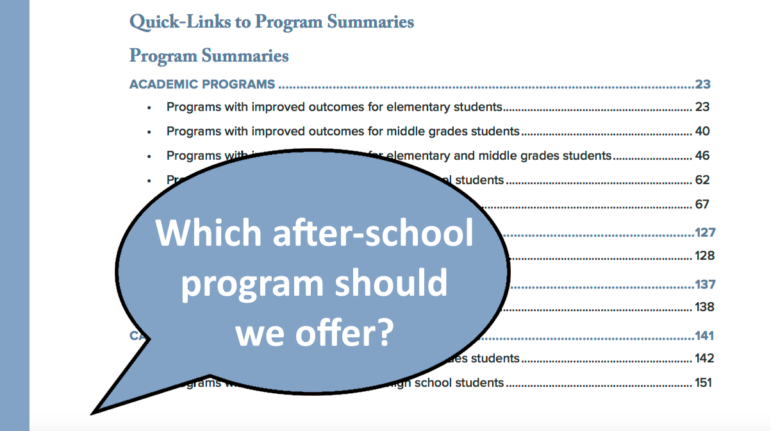
Looking for funding for an after-school program? Trying to decide what type of program to implement?
A report commissioned by the Wallace Foundation offers a guide to programs that have been studied and evaluated. Under the Every Student Succeeds Act (ESSA), providers and school leaders are trying to figure out the appropriate request when they seek funding, said Ruth Curran Neild, one of three authors of the report and a senior researcher at Research for Action, a nonprofit that does research on educational outcomes.
Programs with evidence of effectiveness are prioritized under ESSA. Information on the evidence base for various programs can help school districts and communities choose among them.
“We did a full scan of any study we could find since 2000 where people had looked at the effects of after-school programs,” Neild said.
“We saw there were a lot of studies. Many of them met the standards for rigorous research requirements,” she said. Studies should be done using a comparison group, which provides a better measure of effectiveness than studies comparing the same students before and after a program.
“The field really had been investing in rigorous studies of the effects of programs,” Neild said.
Sixty-two programs meet the evidence requirements of ESSA and show positive impacts on students, she said.
The programs focus on different things: from academics to physical fitness to career readiness. Some are some identified are “homegrown,” other are “branded” or well-developed models, Neild said.
The majority of those that had been researched were ones intended to improve students’ academic performance — the hardest outcome to accomplish, she said. Other programs sought other outcomes, such as increased physical activity, greater school engagement or higher graduation rates.
The companion guide to the report lists every program, its characteristics and a summary of the research on it. This may be the most useful information for after-school providers, Neild said. ESSA defines four levels of effectiveness; the report identifies which levels programs fall into.
But program evidence is only one tool among others. “Research is not meant to replace good professional judgment or provider knowledge,” Neild said.
Local leaders and after-school providers need to consider the needs and priorities of their community, as well as the resources available to them. she said. They need to consider how hard the program is to implement and what they can reasonably expect from it, she said.
“It all needs to come together in a sensible decision-making process,” she said. Just because a program was shown to produce one outcome in a particular context doesn’t mean it will have the same impact elsewhere, she said. “It’s not a guarantee it’s going to work in your context.”
But seeing the evidence behind a program is useful information for decision-makers.
It’s also useful as a comparison with vendor-supplied evidence, the report said.





























